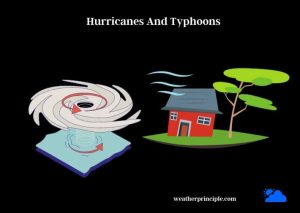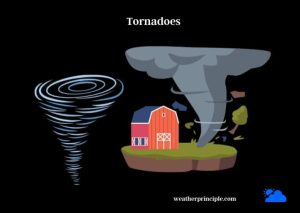Published on: May 4, 2023
Written by Shaown Khan / Fact-checked by Kader Khan
Hailstorms are a severe weather phenomenon characterized by the formation and precipitation of hailstones – solid balls or irregular lumps of ice. These storms often accompany thunderstorms and can cause significant damage to property, agriculture, and infrastructure.
The formation of hailstones is a complex process that involves the interaction of water droplets, ice particles, and the updrafts and downdrafts within a thunderstorm. In this article, we will delve into the science behind hailstorms, their formation, impacts, and how to stay safe during such an event.
Hailstorm Climatology
The global distribution of hailstorms
Hailstorms can occur anywhere in the world but are most common in regions with frequent severe thunderstorm activity. The highest frequency of hailstorms is observed in North America, Europe, Asia, and parts of Africa and South America.
The most hailstorm-prone regions in the United States
In the United States, hailstorms are most prevalent in an area known as “Hail Alley,” which includes parts of Texas, Oklahoma, Colorado, Kansas, Nebraska, and South Dakota. The Front Range of the Rocky Mountains in Colorado is particularly hail-prone due to its geography and climate.
Hailstorm Formation
The role of thunderstorms
Thunderstorms provide the perfect environment for hail formation. Their strong updrafts carry water droplets high into the atmosphere, where they freeze and combine with other ice particles, eventually forming hailstones.
The process of hailstone growth
As hailstones grow, they are carried by updrafts and downdrafts within the storm, encountering supercooled water droplets along their journey. These droplets freeze upon contact, causing the hailstones to grow in size. When the hailstones become too heavy for the updrafts to support, they fall to the ground as precipitation.
Hailstone Characteristics
Size and shape variations
Hailstones can vary in size from tiny pellets to large spheres several inches in diameter. The size of a hailstone is determined by factors such as the strength of the updraft, the number of supercooled water droplets encountered, and the amount of time spent in the storm.
Hailstone composition
Hailstones are composed primarily of ice, with layers of varying clarity and density. They can also contain small amounts of dust, debris, and other atmospheric particles that become trapped during the hailstone’s formation.
Meteorological Conditions Favoring Hailstorms
Atmospheric instability
Atmospheric instability, characterized by rapidly rising air parcels and strong vertical wind shear, is a key factor in the development of severe thunderstorms and hailstorms. This instability provides the energy needed for strong updrafts and supports the growth of hailstones.
Wind shear and its impact
Wind shear, or the change in wind speed and direction with height, plays a critical role in hailstorm formation. Strong vertical wind shear can help organize and sustain the updrafts and downdrafts within a storm, allowing hailstones to grow to significant sizes before falling to the ground.
Hailstorm Detection
Doppler radar technology
Doppler radar is a valuable tool for detecting hailstorms. By analyzing the radar’s returned signals, meteorologists can identify areas within a storm that have high reflectivity, which may indicate the presence of large hailstones. In addition, Doppler radar can provide information on the storm’s structure and intensity, aiding in the forecasting of hailstorms.
Satellite imaging and monitoring
Satellite imagery can also be used to monitor and detect hailstorms. High-resolution satellite images can reveal the development and movement of storm systems, while specialized instruments can detect the presence of ice particles within a storm, suggesting the potential for hail formation.
Hailstorm Forecasting
Predictive modeling techniques
Meteorologists use various predictive modeling techniques to forecast hailstorms. These models incorporate data from weather observations, satellite imagery, and radar to simulate the atmosphere and predict the development of severe weather events, including hailstorms.
The role of meteorologists and weather agencies
Meteorologists and weather agencies play a vital role in hailstorm forecasting. By monitoring and analyzing weather data, they can issue timely warnings and advisories to help the public prepare for and respond to hailstorms, minimizing potential damage and ensuring public safety.
Hailstorm Preparedness
Safety guidelines for individuals
During a hailstorm, it is crucial to prioritize personal safety. Stay indoors, away from windows, and avoid using electronic devices connected to power outlets. If caught outdoors, seek shelter in a sturdy building or vehicle. In the absence of shelter, protect your head and body with clothing or any available objects.
Protecting property and vehicles
To protect property from hail damage, close windows and doors, secure outdoor furniture, and consider installing impact-resistant roofing materials. For vehicles, park in a garage or under a carport when possible. If no shelter is available, use car covers or blankets to shield your vehicle from hailstones.
Hailstorm Impacts
Agricultural consequences
Hailstorms can have devastating effects on agriculture, damaging crops, and reducing yields. In some cases, entire fields can be destroyed, leading to significant financial losses for farmers and impacting food supply chains.
Infrastructure damage
Hailstorms can cause substantial damage to infrastructure, such as buildings, vehicles, power lines, and communication networks. The cost of repairing or replacing damaged property can be immense, placing a financial burden on individuals, businesses, and communities.
Environmental impacts
Hailstorms can also have environmental consequences, such as increased runoff and soil erosion, which can disrupt ecosystems and degrade water quality.
Notable Hailstorm Events
Record-breaking hailstorms in history
Throughout history, there have been several notable hailstorms that have caused significant damage and loss of life. These events serve as stark reminders of the power and destructive potential of hailstorms.
Lessons learned from past events
Studying past hailstorm events can provide valuable insights into the factors that contribute to their formation and severity. This knowledge can help improve our understanding of hailstorms, enhance our ability to predict and prepare for them, and ultimately reduce their impacts.
The Future of Hailstorm Research
Advances in meteorological science
As meteorological science continues to advance, our ability to detect, predict, and respond to hailstorms will improve. Innovations in radar technology, satellite imaging, and predictive modeling will enhance our understanding of hailstorm formation and behavior, leading to more accurate forecasts and more effective preparedness measures.
Climate change and its effects on hailstorm frequency
Climate change may have a significant impact on hailstorm frequency and intensity. As global temperatures continue to rise, the atmosphere may become more unstable, leading to an increase in the occurrence of severe weather events, including hailstorms. Further research is needed to understand the precise relationship between climate change and hailstorm activity, but it is clear that adaptation and preparedness will become increasingly important in the face of a changing climate.
Summary
Hailstorms are a fascinating and powerful weather phenomenon that can cause significant damage and disruption. Understanding the science behind their formation, the factors that contribute to their development, and the impacts they can have is crucial for effective preparedness and response. As meteorological science advances and the climate continues to change, it is more important than ever to stay informed and be prepared for the challenges posed by hailstorms.
Frequently Asked Questions (FAQs)
How can I protect my home and car from hail damage?
To protect your home, consider installing impact-resistant roofing materials and ensure windows and doors are closed and secured during a hailstorm. For vehicles, park in a garage or under a carport whenever possible. If no shelter is available, use car covers or blankets to shield your vehicle from hailstones.
What should I do if I’m caught in a hailstorm?
If caught outdoors during a hailstorm, seek shelter in a sturdy building or vehicle. In the absence of shelter, protect your head and body with clothing or any available objects. If you are driving, pull over to a safe location and wait for the storm to pass.
How do meteorologists predict hailstorms?
Meteorologists use a combination of predictive modeling techniques, radar data, satellite imagery, and weather observations to forecast hailstorms. By analyzing this information, they can issue warnings and advisories to help the public prepare for and respond to hailstorms.
What factors contribute to the formation of hailstones?
Hailstones form in thunderstorms with strong updrafts that carry water droplets high into the atmosphere, where they freeze and combine with other ice particles. Atmospheric instability, characterized by rapidly rising air parcels and strong vertical wind shear, is a key factor in the development of hailstorms.
Are hailstorms becoming more frequent due to climate change?
While further research is needed to understand the precise relationship between climate change and hailstorm activity, it is possible that rising global temperatures could lead to an increase in the occurrence of severe weather events, including hailstorms. This highlights the importance of adaptation and preparedness in the face of a changing climate.
Relevant Resources:



